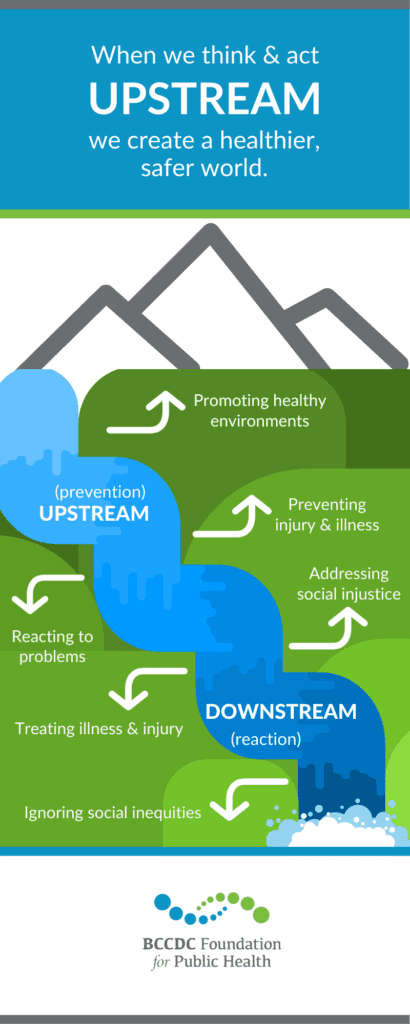Word of the day: Upstream. Nope, not talking about fishing, that’s definitely not our area of expertise. Nor are we talking about an actual stream. Rather, this Decoding Public Health story is centred on a metaphorical stream. Upstream has become a key analogy for how we need to think about health. An analogy that encourages us to take action to prevent illness and injury, protect people, promote environments that foster good health, and importantly, to address social injustice.
These are ‘upstream actions’.
In our current system, we’re battling against the stream – we treat illness, we fix injuries, we throw resources at problems once they exist. That’s exhausting. Imagine if we stopped struggling against the current. It’s not complicated or novel; why then do we insist on putting all our effort at the end instead of the beginning?

Last month, we talked about the social determinants of health (SDOH). Upstream thinking and the SDOH can’t be separated because much of what we talk about in relation to SDOH requires upstream thinking. People who are socially disadvantaged also experience health disadvantages. Inequity creates conditions in which achieving good health becomes challenging, and indicators of health are poorer. It’s problematic when we only talk about healthy lifestyles, but don’t address the social and environmental factors where a person lives, works, and plays.
We all care about health. We all want to be safe. In order to achieve that, we must address the factors that influence our health and safety, such as income, education, the environment, social justice, and more. Medical solutions, disease control, behaviour change—these are all imperative for a healthy society. But they aren’t enough. They alone will not create a healthy society. The only way to truly have a healthy world is by addressing the conditions around us.
Upstream action addresses those circumstances.
A simple and widely understood example is early childhood development. When a child is nurtured with the things needed to grow, learn, and thrive, that child matures into a healthy adult. Optimizing a child’s development between 0-8 years old is critical to protecting them later in life.
Another is housing. Consider the ‘housing first model’ to address homelessness. This model focuses on getting people housed first, not waiting until other issues are solved (employment, for example) before finding housing. It’s a pretty basic premise: get people in safe and secure housing, where they can then focus on dealing with their other needs, e.g. mental health or addiction. Removing the barrier of homelessness lifts people up, reduces the inequality gap, and gives people a chance to thrive.
Another example is universal basic income. A hot button topic, but the principle of which is to help boost everyone up to a level from which they can make a difference to their own lives and take care of themselves and their families. It’s a social safety net with an emphasis on equity.
These are examples of upstream actions.
When we think and act upstream, we create a healthier and safer world. This applies both to individuals needing support, and to the world at large needing major change. Small or big, upstream solutions must become the way of our future. It’s time to start thinking about health in a less traditional way; it’s time for different sectors to work together to create solutions that address inequalities and ultimately to create a healthy and equitable world.
It’s time to agree that social injustice is a disease, making too many people sick.
